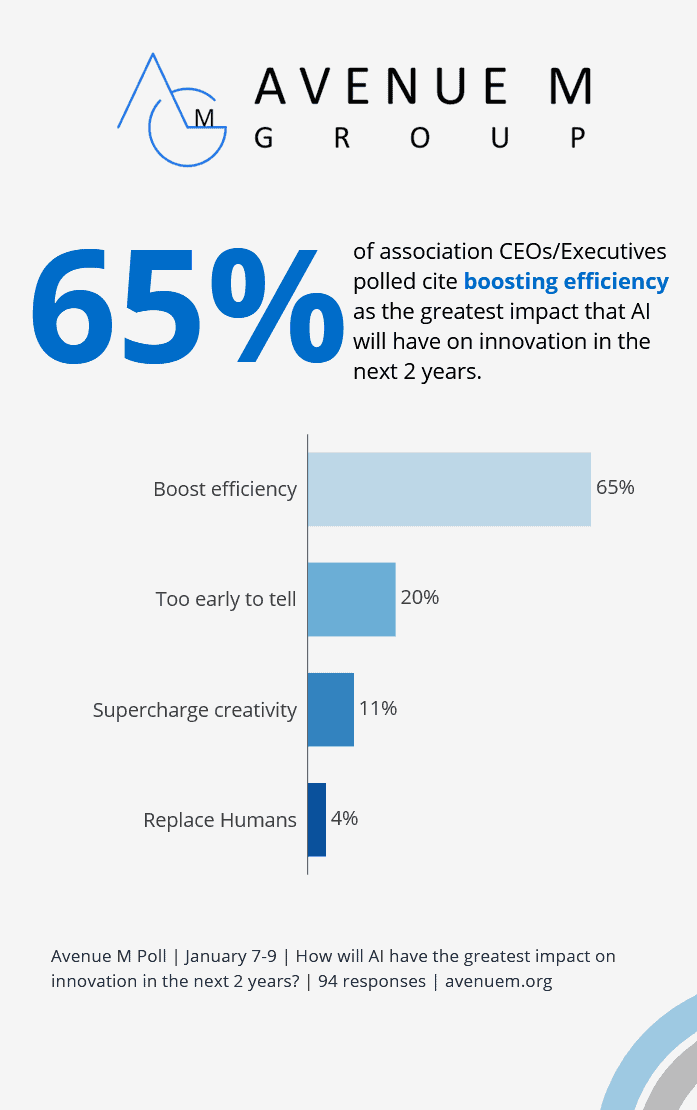Associations are increasingly turning to AI to streamline tasks, enhance efficiency, and free up staff for more impactful and creative work, with a recent poll revealing growing optimism about its transformative potential—despite some lingering uncertainty.
AI has fast-tracked from a futuristic concept to an everyday tool, reshaping how organizations work. While some people are wary of embracing a more mainstream tool, lots of associations—if they haven’t already—are harnessing AI to tackle repetitive tasks, allowing staff to focus on projects that inspire creativity and innovation.
AI: From Future Fear to Present Productivity
 Avenue M recently conducted a quick poll of 94 executives, and the results reflect growing excitement about AI’s potential to transform work.
Avenue M recently conducted a quick poll of 94 executives, and the results reflect growing excitement about AI’s potential to transform work.
- 65% believe AI will boost efficiency within the next two years.
- 20% say it’s too soon to tell, reflecting cautious optimism.
- 11% think it will spark more creativity.
- And only 4% have a more pessimistic outlook, believing that AI will one day replace humans.
These numbers highlight a significant shift: Associations are moving past fear and skepticism, embracing AI as a tool to simplify workflows and enhance productivity. One executive summed it up perfectly: “AI won’t replace your job. But someone who knows how to use AI better than you might.”
Poll Results: Optimism Meets Uncertainty
Many leaders are observing the benefits of AI firsthand. “I have already started to see some organizations use AI to help staff with their work,” one executive, who believes AI will increase efficiency, said. Efficiency gains from AI can also enhance creative potential within associations. As administrative tasks become automated, staff gain the capacity for more engaging work.
“I also believe that creativity will naturally be supercharged as staff becomes more efficient and time is freed up for projects that rely on humans and creativity,” the executive added.
This perspective highlights a broader shift as associations begin to view AI as a practical tool rather than a daunting, futuristic concept. “I see it as a productivity tool, e.g., helping draft an email or letter instead of starting with a blank page,” one leader said. Another observed, “AI will eliminate a number of activities that previously involved a lot of manual work, freeing up time to be more strategic.”
Real-Life Wins: AI in Action
AI’s impact is already evident in associations that have adopted it:
- Streamlined Workflows: Automating tasks like data entry and scheduling saves hours every week.
- Enhanced Member Engagement: AI-powered insights reveal member behavior, enabling more personalized communication and stronger retention.
- Creative Freedom: As AI takes on repetitive tasks, staff can focus on brainstorming, strategizing, and innovating.
One executive captured the essence of this shift: “AI frees up time for projects that rely on human creativity, giving staff the chance to truly shine.”
AI can help association staff manage complex tasks by automating data entry, scheduling, and member communications, freeing teams to focus on strategy and relationship building. It also offers deeper insights into member behavior, enabling more personalized experiences and stronger retention.
As AI tools like chatbots and automated reporting become more accessible, the next two years will be key for the associations that adopt them. While challenges like staff training and data privacy remain, AI’s potential to amp up efficiency and deliver greater member value is clear.
The Final Word: AI is Here to Stay
AI is no longer the future—it’s the present. Associations that embrace its potential today will lead tomorrow’s innovation. Whether it’s drafting emails or streamlining operations, AI is transforming the way we work, empowering teams to do what they do best: think big, collaborate, and create.
What role will AI play in your organization’s success story? The possibilities are endless.
Want to participate in future text polls? You can sign up HERE.
For more insights into AI’s potential in the workplace, read Avenue M’s quick summaries of the following resources, and click the links below.
The Many, Many Ways AI Spurs Innovation
Top innovators use technologies like AI to get ahead, with one survey showing they’re exceeding expectations by using emerging tech to create or disrupt markets—more aggressively than most executives.
AI speeds up innovation by making experimentation faster and cheaper. Generative AI simplifies testing new ideas, which helps businesses explore growth opportunities. For example, it can quickly create marketing content for A/B testing, boosting efficiency and results.
Will AI Boost Productivity? Companies Sure Hope So.
Companies are using AI in customer experiences, hoping it will boost productivity and expand profits without raising prices. While higher productivity could allow for wage increases and growth, some economists are skeptical, believing AI–especially generative tools–hasn’t yet had a significant impact on productivity, unlike the transformative gains seen in the 1990s.
Some are optimistic, like an economist who found AI boosted productivity in a call center, especially for newer workers. Companies are using AI for tasks like pricing, HR support, and customer service, with tools like Walmart’s “My Assistant” app streamlining work. While the long-term impact is debated, many businesses see AI as a game-changer for efficiency.
Generative AI Can Boost Productivity Without Replacing Workers
AI tools have sparked both excitement and concern, with some predicting they’ll transform the economy while others fear job losses and inaccurate results. One study found that workers using AI assistants became more productive, resolved issues faster, and stayed in their jobs longer, with the biggest improvements seen among less experienced staff who learned faster with AI support.
The study also showed happier customers and lower employee turnover, as the AI helped workers solve problems more effectively. Rather than replacing jobs, the research suggests AI can benefit workers, customers, and businesses alike by boosting productivity and job satisfaction.
Want to be the first to be notified about articles like this? You can learn more about Avenue M’s texting poll service HERE.
Contributors: Sheri Jacobs, FASAE, CAE & Lisa Boylan
Image: Adobe Stock